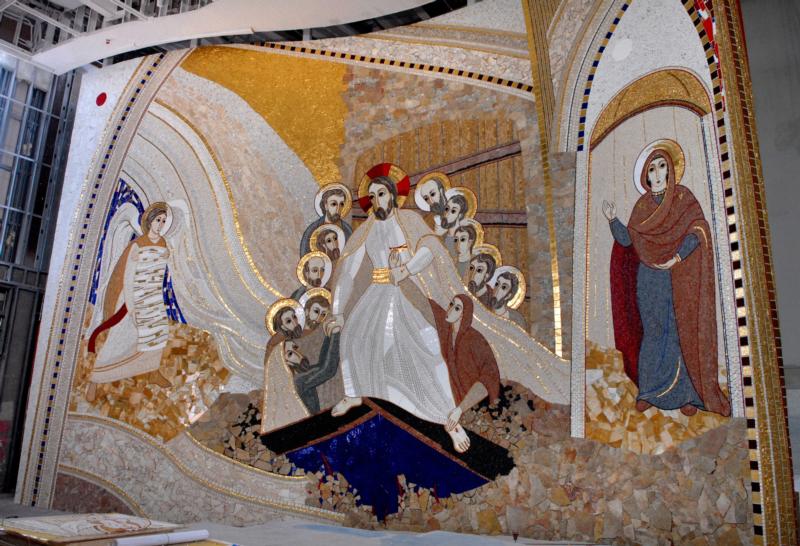
A mosaic depicting Jesus the Risen Savior, surrounded by his disciples as he pulls Adam and Eve from the depths of hell to salvation, is seen in 2008 at Sacred Heart University’s Chapel of the Holy Spirit in Fairfield, Conn. Human sinfulness and God’s never-ending forgiveness are central themes of the entire Bible, Old and New Testament alike. (CNS photo/Tracy Deer-Mirek, courtesy Sacred Heart)
Human sinfulness and God’s never-ending forgiveness are central themes of the entire Bible, Old and New Testament alike.
Beginning with the sin in the garden in Genesis 3:1-7, through God’s mercy towards Cain, on through the histories and prophets, and then into the teachings of Jesus in the Gospels, the story remains the same: We sin, and God calls us back with forgiveness.
One of the high holy days in the Jewish year is Yom Kippur, “the Day of Atonement,” described in Leviticus 16:29-30. On this day, people do penance, or atone, for the sins they have committed against God during the past year. Before one can seek atonement with God for the sins committed against another person, one must first seek to right the wrong and be reconciled with that person.
[hotblock]
Isaiah 58:1-12 beautifully addresses what we are called to do to make amends: We are to recognize our sinfulness and to tell it to others (58:1). Then, we are to act with justice toward those whom we have harmed:
“Is this not, rather, the fast that I choose: releasing those bound unjustly, untying the thongs of the yoke; setting free the oppressed, breaking off every yoke? Is it not sharing your bread with the hungry, bringing the afflicted and the homeless into your house; clothing the naked when you see them, and not turning your back on your own flesh?” (58:6-7) Only then will we be vindicated; only then will we be forgiven (58:8).
Jesus picks up this theme in his teaching, especially in the presentation of the beatitudes (Mt 5:3-12, Lk 6:20-45) and when he taught his disciples how to pray: “Forgive us our sins for we ourselves forgive everyone in debt to us” (Lk 11:4, see Mt 6:1-18 and Lk 11:1-13 for the full context).
While in his teaching Jesus echoes the beliefs of his Jewish ancestors, something new enters into the equation with his death and resurrection: “The blood of his son Jesus cleanses us from all sin” (1 Jn 1:7).
As the International Theological Commission observed in its 1982 statement on penance and reconciliation, “It is not that we reconcile ourselves with God; it is God who through Christ reconciles us to him.”
And as 1 John 2:1-2 puts it, “If anyone does sin, we have an advocate with the Father, Jesus Christ the righteous one. He is expiation for our sins, and not for our sins only but for those of the whole world.”
While our current practice of individual confession and penance developed after biblical times, there are numerous scriptural passages that support the practice. One in particular stands out.
Following his resurrection, Jesus appears to his disciples. After breathing upon them, he said, “Receive the Holy Spirit. Whose sins you forgive are forgiven them, and whose sins you retain are retained” (Jn 20:22-23; see also Mt 18:18).
The sacrament of reconciliation encourages us to go and to try to sin no more. This teaching is found also in Ephesians 4:25-32 and 1 John 1:5-10.
***
Mulhall is a catechist living in Louisville, Kentucky.
PREVIOUS: Been away from confession? God’s mercy still calls
NEXT: Through the sacrament of reconciliation, God’s mercy flows into our lives



Share this story